|
|
|
INTRODUCTION TO TERMINOLOGY AND TECHNIQUES |
Sex:
For species in which plumage differs between males and females, we provide
photos of both (if available). Many other species show no difference
in plumage, and photos of these are generally labeled 'U' (unknown) unless
the sex of the individual has been determined by other means (e.g. brood
patch for females or cloacal protuberance for males during the breeding
season).
Age:
Ages are presented in the standard notation used by banders. Most
species cannot be reliably aged beyond after-second-year. The
classifications and abbreviations used are:
juv - juvenile: a recently hatched bird, prior to its
preformative moult (also known as its first prebasic moult)
HY - hatch year: a bird hatched earlier the same year
AHY - after hatch year: a bird hatched in a previous
year
SY - second year: a bird in its second calendar year (HY
becomes SY as of January 1)
ASY - after second year: a bird beyond its second
calendar year
TY - third year: a bird in its third calendar year (SY
becomes TY as of January 1)
ATY - after third year: a bird beyond its third
calendar year
Our approach: body, wings, and tail:
For most species, we try to provide photos of the upper body from
the side, as well as the upper surface of the wing, and the tail.
Collectively, these areas usually provide the best clues to ageing and
sexing of individuals. For some species, other characteristics are more
useful (e.g. underwing on blackbirds or bill on hummingbirds) and we
feature these instead, or in addition to the usual views.
The side view of the body is often not
enough in itself to permit for reliable ageing and sexing. However, it
provides context and overall plumage cues that can be useful in
conjunction with features on the wing and tail. In some cases, molt
limits on the wing are distinct enough that they can be seen with
practice even on the closed wing, permitting for the ageing of
free-flying birds (at least at close range).
In many cases the wing provides the most
information about the age of a bird by virtue of the presence (or
absence of molt limits). See the section on molt below for details.
The shape and condition of the rectrices
(tail feathers) are also a useful ageing tool for many species.
Generally speaking, juvenile rectrices are narrower, and more pointed
at the tip than adult feathers. They also tend to be of lesser quality,
showing greater signs of fraying, especially by spring. However, the
usefulness of the tail can vary considerably from species to species.
In some, tail shape varies little by age; in others (especially largely
terrestrial birds such as sparrows) even adult feathers are often quite
battered and frayed by spring. Beware too that sometimes juveniles lose
their entire tail prematurely, and when it regrows it features adult
rectrices. We generally try to comment on the usefulness of the tail in
the introductory section of each account, but bear in mind that there is
always considerable potential for individual variation, and for most
species it is risky to base an ageing assessment solely on the tail,
especially if the rectrices appear adult.
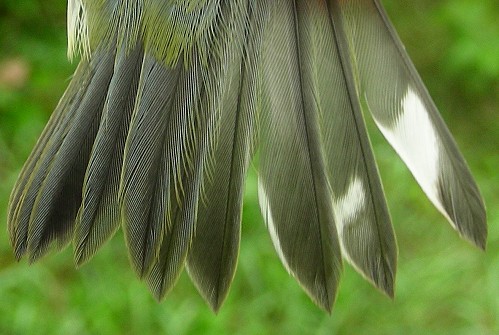
A typical HY
tail, with relatively narrow and pointed rectrices
(Northern Parula by Marie-Anne Hudson) |
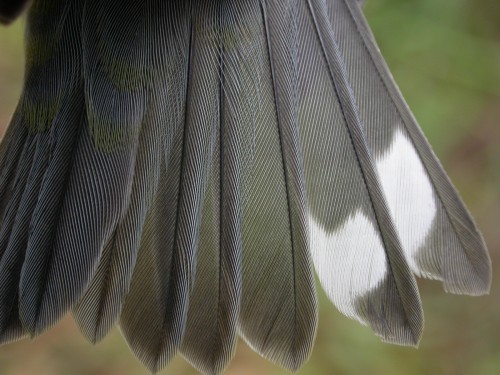
A typical AHY
tail, with relatively broad and round rectrices
(Northern Parula by Marcel Gahbauer) |
Identifying molt limits:
Being able to recognize and understand molt limits is critical to
ageing most passerines. Simply put, a molt limit is the location within
or between feather tracts where feathers of two different generations
appear side by side. In most North American passerines, molt limits
occur primarily in HY/SY birds and represent the contrast between
retained juvenile feathers and replaced adult feathers. Whereas most
species undergo a complete prebasic molt each summer/fall as adults,
most only have a partial or incomplete preformative (or first prebasic)
molt as HY birds. Therefore the presence of molt limits serves to
indicate HY/SY birds, whereas plumage of uniform quality generally is
indicative of AHY/ASY birds. Again, consult the individual species
accounts for species-specific exceptions to this general rule.
In most cases, molt limits are evident as a
contrast in colour between retained and replaced plumage. Sometimes
this is a stark and unmistakable contrast; other times it is more
subtle. The contrasts tend to be more pronounced in spring, for two
reasons. First, the juvenile feathers will have faded more by spring,
contrasting more noticeably with basic (adult) feathers grown in the
previous fall. Second, for species that also undergo a prealternate
molt (which produces what is commonly known as “breeding plumage”), the
contrast between the fresh (and often brighter or darker) alternate
plumage and the retained juvenile feathers is even more noticeable. One
general caution with respect to colour is that some species have “pseudolimits”,
i.e. feather tracts that are always distinct in colour from adjacent
feathers – a good example of this being many of the sparrows, with
darker tertials that contrast visibly with the adjacent secondaries even
if they are of the same generation.
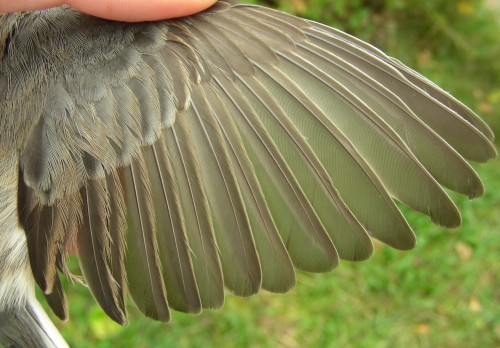
A fairly common
HY molt pattern, with the primary coverts and outer two
greater coverts unreplaced and brownish, contrasting with
the fresh gray basic inner greater coverts. Note also
the contrast between the replaced inner greater coverts and
the brownish unreplaced tertials.
(Slate-coloured Junco by Marie-Anne Hudson) |
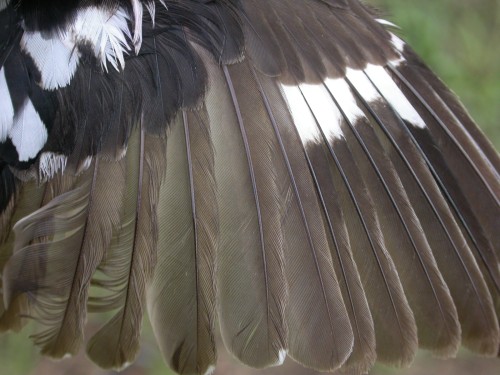
A very dramatic
example of a molt limit on a SY Rose-breasted Grosbeak,
showing the contrast between the brown juvenile primary
coverts, primaries, and secondaries, and the black greater
coverts replaced during the prealternate molt.
(Rose-breasted Grosbeak by Marcel Gahbauer) |
For species where colour contrasts are less
obvious (often those with gray/green/brown wings – i.e. quite a number
of them). Especially in these cases, it is useful to also look closely
at the quality of the feathers. Especially by spring, juvenile feathers
often are visibly more worn or frayed, in addition to being faded.
However, the reason that they are more easily damaged is in large part
due to the lesser structural integrity they have. This can be seen even
when they are fresh – juvenile feathers generally have far fewer barbs
than adult feathers, i.e. looking closely at the feathers, the barbs are
visibly further apart. This takes both good eyesight and practice to
spot, but can be a useful tool when colour differences are unclear.
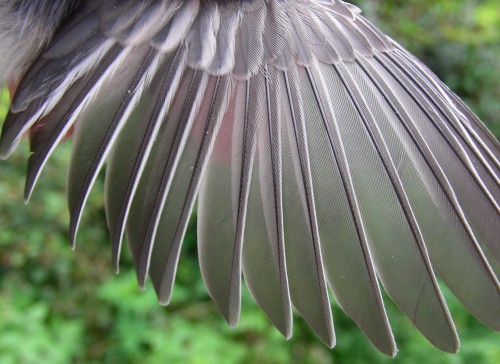
On this wing, a
molt limit can be detected by colour within the greater
coverts; however, as there can be a gradient of colour among
the greater coverts even on adult chickadees, this should be
viewed with caution.
(Black-capped Chickadee by Marcel Gahbauer) |
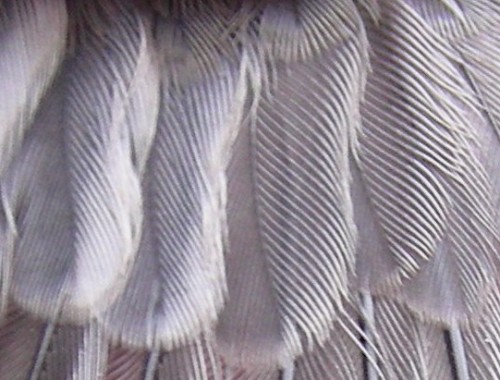
A zoomed in view
of the outer four greater coverts of the same wing show a
difference in structure - the outer two greater coverts have
distinctly wider spacing between barbs than do the replaced
feathers at left.
(Black-capped Chickadee by Marcel Gahbauer) |
Of course, knowing where to look for molt
limits is also very important. Most commonly, they occur between the
primary coverts and the greater coverts, or among the greater coverts.
However, other patterns occur – sometimes they are within the primaries
or secondaries; other times they may be limited to the median coverts.
Again, we try to point out the typical patterns in the individual
species accounts.
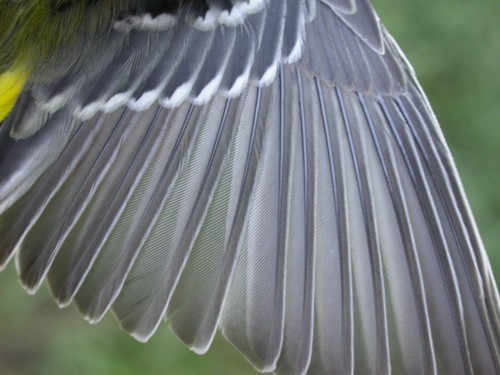
One of the most
common molt limit patterns, with all of the greater coverts
replaced during the preformative molt, but all of the
juvenile primary coverts, primaries, and secondaries
retained.
(Magnolia Warbler by Marcel Gahbauer) |
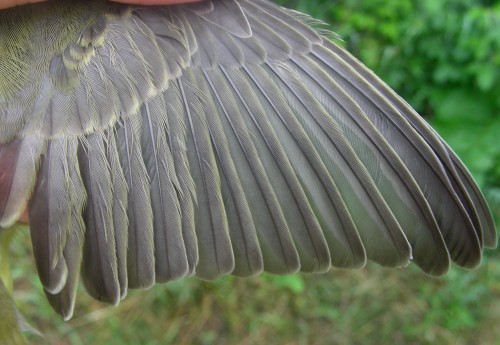
Occasionally
only very few feathers are replaced during the preformative
molt, as in this case where just a few fresh median coverts
contrast with all of the juvenile greater and primary
coverts.
(Scarlet Tanager by Marie-Anne Hudson) |
Seasonal tips:
Identification is complicated by the fact that birds (to varying
degrees) change their appearance over the course of the year. In some
cases these changes are subtle, merely the difference between fresh
plumage after a molt, and increasingly worn plumage over time. In
others, a molt results in drastic alterations in appearance. Knowing
the nature, and just as importantly the timing, of these changes is
critical. We generally aim to provide “spring” and “fall” photos of
each species, recognizing that both birding and banding activity peak
during migration. To a large extent, species appear similar in summer
as they do in spring, and in winter as they do in fall – but where
exceptions occur, we attempt to make note of them.
Fall:
This is the season of the infamous “confusing fall warblers” as named by
Roger Tory Peterson, and some of them do present some good challenges.
However, with practice, the presence or absence of molt limits can be
used to reliably age most fall birds. Since juvenile plumage is still
relatively fresh at this time (often only a month or two older than
feathers that have been replaced in the preformative molt), molt limits
can sometimes be rather subtle. For species where tail shape is
informative, using it in combination with looking for molt limits on the
wing generally produces more confident results – or where features
conflict, suggest that an individual should be left as age unknown. For
banders who have the bird in hand, checking skull ossification is also
possible for most species at least part way through fall, but as this
cannot be photographed adequately nor seen in free-flying birds, we
generally do not discuss it in our species accounts.
Winter:
Most species change little in appearance between fall and winter.
Generally retained juvenile feathers become increasingly worn and faded
over time, making it somewhat easier to distinguish HY/SY vs. AHY/ASY
birds as winter progresses. Some species also continue to molt
gradually over winter, American Goldfinch being a good example.
Spring:
For many species, the contrast between juvenile and adult feathers
becomes increasingly pronounced by spring, making it easier to tell SY
and ASY birds apart than it is to distinguish between HY and AHY birds
in fall. To some extent this is particularly true for those which
undergo a partial prealternate molt in spring – examples of very blatant
molt limits are SY male Rose-breasted Grosbeaks or Baltimore Orioles.
However, at other times the prealternate molt can create confusion,
since it is generally only partial, and therefore will create molt
limits between feathers replaced in spring and the previous generation –
which may be either juvenile or basic. A good rule of thumb is to count
the molt limits – if only one is visible (i.e. only two distinct
generations of feathers), then chances are that they represent basic
plumage from a complete prebasic molt the previous summer/fall
contrasting with some new prealternate feathers, and the bird’s age is
ASY. But beware that the preceding rule holds only for species
undergoing a prealternate molt – for those that do not have one, a
single molt limit visible in spring is still indicative of a SY bird!
On the other hand, if there are two separate molt limits present (i.e.
three distinct generations of feathers), then it is almost certainly a
SY bird as for most species the only explanation is that there are
juvenile, first basic, and first prealternate feathers present.
Summer:
In some ways, summer poses the greatest challenges. Juveniles of
some species go through a period (often brief, but still long enough to
cause confusion) of having distinct plumage, that often is not shown in
field guides. An example of this (one of the few that is commonly
known) is the spot-breasted plumage of juvenile American Robins.
Others, such as “gray” juvenile Yellow Warblers retain their plumage
for much shorter periods and are generally not illustrated, but can
therefore pose quite an identification challenge on the rare occasion
that they are seen.
A second challenge is that adults of most
species undergo their complete prebasic moult in summer, generally after
the breeding season has completed. Birds seen in mid-moult can pose
quite an identification challenge, as they are often very scruffy and
missing much of their usual plumage that typically aids in
identification. Those that are second-year birds transitioning into
full adult plumage for the first time can look in particularly rough
shape, since their remaining juvenile feathers after one year are often
of very poor quality. For some species we have included photos of birds
in mid-moult to highlight how different they are in appearance from what
is normally seen.
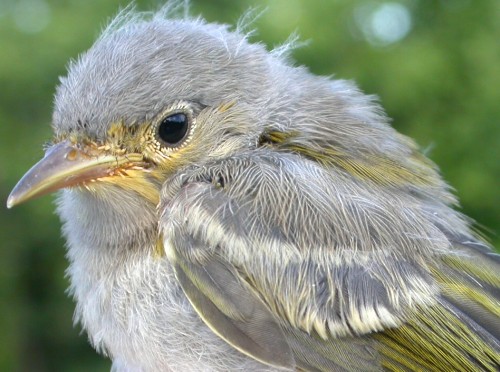
A juvenile
Yellow Warbler in this gray plumage looks nothing like
anything found in most field guides!
(Yellow Warbler by Marcel Gahbauer) |
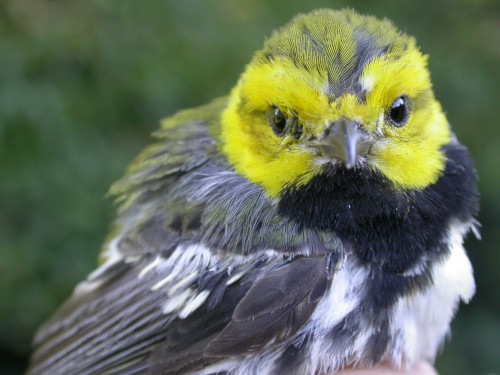
A male
Black-throated Green Warbler in mid-moult in early August,
with a very old and brown alula suggesting it may be a
second-year bird.
(Black-throated Green Warbler by Marcel Gahbauer) |
Still confused?
Let us know - we'd be happy to try to clarify any points that are
unclear. Just e-mail us
and identify your concerns as specifically as possible.
|










